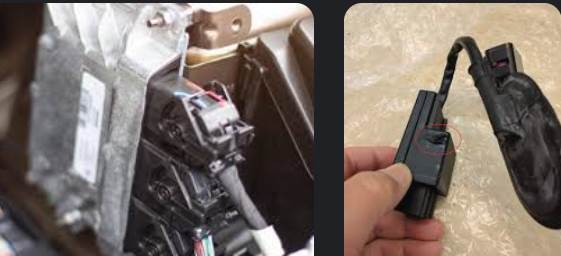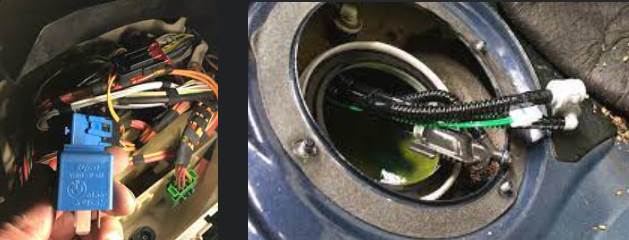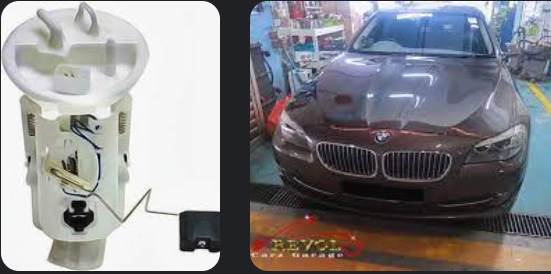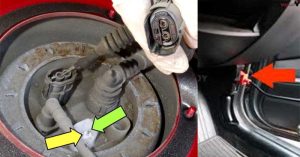Uncover critical BMW fuel pump failure signs, understanding the control unit’s role, and learn when to seek a mechanic’s expertise for your fuel pump control module.
Navigating the complexities of modern automobile technology can be daunting for the uninitiated. However, understanding the essential functions and recognizing early signs of failure, especially when it pertains to pivotal components like the fuel pump control module, is vital to timely intervention and preserving the health of your BMW. We’ll talk about signs of a failing BMW fuel pump control module and advise on the appropriate actions.
Difficulty Starting the Car
When you repeatedly turn the ignition key or push the start button, only to be met with a reluctant engine, it could be an early symptom of a failing fuel pump control module.
The symptom manifests as a sporadic difficulty in starting your car, usually increasing in frequency as the module’s condition worsens. The situation might be more pronounced in cold weather conditions or after the car has been parked for an extended period.
| Symptom | Description |
|---|---|
| Hard starting | Repeated attempts needed to start the car. |
| Intermittent starting issues | Starting problems increase over time. |
The fuel pump control module is crucial to your BMW’s fuel system. It oversees the fuel pump operation, ensuring an adequate fuel supply to the engine based on its demands. A faulty module may disrupt this operation, leading to inadequate fuel supply and issues in starting the car.
Contents
 Should you experience persistent starting issues, it is advisable to consult with a good professional mechanic or a BMW service center. They have the requisite expertise and equipment to diagnose whether the issue is related to the fuel pump control module or stems from other components in your BMW.
Should you experience persistent starting issues, it is advisable to consult with a good professional mechanic or a BMW service center. They have the requisite expertise and equipment to diagnose whether the issue is related to the fuel pump control module or stems from other components in your BMW.
Moreover, paying attention to these signs is imperative, as a failing fuel pump can lead to more serious engine problems if left unchecked.
| Action | Guideline |
|---|---|
| Professional Consultation | Reach out to a mechanic or a BMW service center if persistent starting issues are experienced. |
| Preventive Measures | Never ignore these signs; a failing fuel pump can escalate to serious engine problems. |
Poor Engine Performance
In addition to starting issues, another significant symptom of a failing fuel pump control module is a drop in engine performance.
Several parameters, including acceleration, fuel efficiency, and the smoothness of the ride, can measure engine performance. When these parameters drop below the average threshold, it indicates poor engine performance. Symptoms might include:
| Symptom | Description |
|---|---|
| Sluggish Acceleration | The car does not respond promptly to acceleration. |
| Decreased Fuel Efficiency | The car consumes more fuel than usual for the same distance. |
| Jerkiness During Rides | The car experiences rough rides with noticeable jerks. |
The fuel pump control module regulates fuel flow from the tank to the engine. When it fails, the fuel supply becomes inconsistent. This irregular fuel supply can cause the engine to receive less fuel than required for optimum performance or more fuel than necessary, leading to inefficiencies. This irregular supply manifests as poor engine performance.
 If you observe a sudden drop in your BMW’s performance, you should get the car checked by a professional mechanic or a BMW service center. A comprehensive diagnosis can help identify whether the fuel pump control module is indeed the cause of the performance drop. Remember, quick and timely action can prevent further damage to your car’s engine.
If you observe a sudden drop in your BMW’s performance, you should get the car checked by a professional mechanic or a BMW service center. A comprehensive diagnosis can help identify whether the fuel pump control module is indeed the cause of the performance drop. Remember, quick and timely action can prevent further damage to your car’s engine.
| Action | Guideline |
|---|---|
| Professional Consultation | Consult a professional mechanic or a BMW service center when the car’s performance drops. |
| Timely Action | Swift diagnosis and action can prevent further damage to the engine. |
Unusual Noises from the Rear of the Car
Unusual noises emanating from the rear of your car can be alarming. When linked to the fuel system, these noises can indicate a fuel pump control module struggling to perform its function.
 You might hear typical noises like whining, humming, or buzzing sounds coming from the back of your vehicle. The sound may become more noticeable when the engine runs, especially during acceleration or when the vehicle runs at a steady speed.
You might hear typical noises like whining, humming, or buzzing sounds coming from the back of your vehicle. The sound may become more noticeable when the engine runs, especially during acceleration or when the vehicle runs at a steady speed.
| Noise | Description |
|---|---|
| Whining | A high-pitched sound that increases in volume with acceleration. |
| Humming | A continuous low-pitched noise that persists while the engine is running. |
| Buzzing | A sound that resembles the noise of an insect, often heard when the vehicle is at a steady speed. |
The fuel pump control module regulates the fuel pump’s power supply, maintaining the correct pressure and volume of fuel delivered to the engine. When the module malfunctions, the pump may run irregularly or struggle to maintain the correct speed, causing it to emit these unusual sounds.
 Upon detecting such noises, please don’t ignore them. They are signals that something is not right with your car. It is recommended to seek the expertise of a qualified mechanic or a BMW service center for a detailed examination. Early detection and rectification can prevent severe potential damage to the fuel pump and other important related components.
Upon detecting such noises, please don’t ignore them. They are signals that something is not right with your car. It is recommended to seek the expertise of a qualified mechanic or a BMW service center for a detailed examination. Early detection and rectification can prevent severe potential damage to the fuel pump and other important related components.
| Action | Guideline |
|---|---|
| Don’t Ignore | Unusual noises should not be ignored as they may indicate a serious issue with your car. |
| Seek expertise | Contact a qualified mechanic or a BMW service center for a thorough examination of the vehicle. |
Decreased Fuel Economy
A more subtle yet equally important symptom of a failing fuel pump control module is a decrease in fuel economy. Understanding this symptom and its link to the module can help ensure the health and longevity of your BMW.
Decreased fuel economy means your BMW consumes more fuel than it should for the distance it covers. You might need to refuel more frequently, even if your driving habits have stayed the same.
| Indicator | Description |
|---|---|
| More Frequent Refueling | If you need to fill up your tank more often than usual, despite maintaining the same driving habits, this may indicate decreased fuel economy. |
The fuel pump control module is pivotal in optimizing fuel delivery to the engine. It ensures that the right amount of fuel is sent at the right time. A malfunctioning module can lead to the fuel pump running continuously or intermittently, causing an excess or shortage of fuel when driving. This imbalance can lead to a drop in fuel efficiency, causing your car to consume more fuel than necessary.
 If you notice a notable decrease in fuel economy, it is advised to get your car checked by a professional. They can perform a fuel pressure test to check the operation of the fuel pump control module and confirm whether it is the source of the issue. It’s crucial to address these issues early, as ignoring them can lead to even more severe damage to your vehicle’s fuel system.
If you notice a notable decrease in fuel economy, it is advised to get your car checked by a professional. They can perform a fuel pressure test to check the operation of the fuel pump control module and confirm whether it is the source of the issue. It’s crucial to address these issues early, as ignoring them can lead to even more severe damage to your vehicle’s fuel system.
| Action | Guideline |
|---|---|
| Monitor Fuel Consumption | Keep a close eye on your fuel consumption, noting any unusual increases in the frequency of refueling. |
| Seek Professional Help | Bring your vehicle to a certified mechanic or BMW service center if you notice a big decrease in fuel economy for a thorough examination. |
The ‘Check Engine’ Light Illuminates
Regarding car issues, the illumination of the ‘Check Engine’ light is often a tell-tale sign of underlying problems, which might be connected to a faulty fuel pump control module. Let’s delve deeper into this subject.
The ‘Check Engine’ light, also known as the famous Malfunction Indicator Lamp, is a built-in warning system in your BMW. This light usually illuminates in a steady glow or a blinking light. A steady glow indicates a non-urgent issue, while a blinking light signals a more immediate concern.
| Light Type | Description |
|---|---|
| Steady Glow | Indicates a minor fault that should be addressed soon. |
| Blinking Light | Suggests an immediate issue requiring urgent attention. |
Your BMW’s onboard computer continuously monitors the performance of your vehicle, including the operation of the fuel pump control module. When the module fails or starts malfunctioning, the computer detects these irregularities and triggers the ‘Check Engine’ light as a warning signal. Therefore, a lit ‘Check Engine’ light could indicate a failing fuel pump control module.
 When the ‘Check Engine’ light illuminates, promptly acting is best. A professional mechanic should be consulted to run a diagnostic check on your BMW. This test will read the car’s onboard diagnostic (OBD) codes, which can reveal whether the problem is due to the fuel pump control module or something else.
When the ‘Check Engine’ light illuminates, promptly acting is best. A professional mechanic should be consulted to run a diagnostic check on your BMW. This test will read the car’s onboard diagnostic (OBD) codes, which can reveal whether the problem is due to the fuel pump control module or something else.
| Action | Guideline |
|---|---|
| Don’t Panic | A lit ‘Check Engine’ light does not necessarily imply a catastrophic failure. Don’t panic, but do not ignore it either. |
| Seek Immediate Assistance | If the ‘Check Engine’ light is blinking, it’s recommended to stop driving and seek immediate professional help. |
| Run a Diagnostic Check | Consult a professional to perform a diagnostic check. It will help identify whether the issue is related to the fuel pump control module. |
Intermittent Power Loss
Another symptom that could point to a failing fuel pump control module in your BMW is intermittent power loss. It can be an unnerving issue for drivers, as it often occurs unpredictably and without clear reason.
Intermittent power loss, as the term suggests, refers to sporadic instances of your BMW losing power. You might notice the vehicle suddenly slowing down, especially when you try to accelerate or climb an incline. This issue can create a stop-and-go driving situation, potentially endangering you and other road users.
| Symptom | Description |
|---|---|
| Unresponsive Accelerator | When accelerating, your BMW doesn’t respond as it should, or there is a delay in power delivery. |
| Loss of Power on Inclines | The vehicle struggles to maintain speed while climbing hills or steep inclines. |
The fuel pump control module is essential in supplying the engine with the right amount of fuel at the correct pressure. If this module is malfunctioning, it can lead to inconsistencies in fuel delivery, resulting in your BMW suffering from intermittent power loss.
 Intermittent power loss is a serious concern and needs immediate attention. It is advised to bring your BMW to a certified mechanic for a thorough inspection.
Intermittent power loss is a serious concern and needs immediate attention. It is advised to bring your BMW to a certified mechanic for a thorough inspection.
| Action | Guideline |
|---|---|
| Don’t Ignore | Any signs of power loss should not be ignored. It can lead to more ugly engine problems if left unchecked. |
| Consult a Mechanic | Bring your BMW to a professional mechanic. They can perform diagnostics to pinpoint the cause of the power loss. |
Engine Sputters or Stalls
As we delve further into the symptoms of a failing fuel pump control module, it is crucial to acknowledge that a sputtering or stalling engine is a red flag that must not be ignored.
The sputtering or stalling of an engine is a common symptom associated with a problematic fuel pump control module. You may find your BMW’s engine behaving irregularly, with inconsistent power delivery that results in the vehicle jerking or sputtering. Worse, the engine may stall entirely, particularly during high-speed operation or under heavy load.
| Symptom | Description |
|---|---|
| Engine Sputtering | Your BMW’s engine runs unevenly or ‘misses’ its firing sequence. |
| Engine Stalling | The engine shuts off completely while driving, especially at high speeds or under heavy loads. |
The fuel pump control module manages the flow of fuel from the big fuel tank to the engine. A malfunctioning module can send inconsistent fuel quantities, leading to the engine sputtering or stalling due to insufficient fuel supply.
 Seeking professional help if your BMW engine begins to sputter or stall is advisable. Ignoring these obvious symptoms could lead to more serious engine damage.
Seeking professional help if your BMW engine begins to sputter or stall is advisable. Ignoring these obvious symptoms could lead to more serious engine damage.
| Action | Guideline |
|---|---|
| Don’t Ignore | Engine sputtering or stalling are serious symptoms that should not be disregarded. They can cause safety risks and lead to more serious engine problems. |
| Consult a Mechanic | As soon as you notice these symptoms, bring your BMW to a professional mechanic. They can conduct diagnostic tests and provide the best solution for the problem. |
Conclusion and Recap
Having journeyed through the common symptoms of a faulty fuel pump control module, we hope you’re better equipped to spot these issues early on. Symptoms can include the vehicle failing to start, decreased fuel economy, the ‘Check Engine’ light illuminating, intermittent power loss, and the engine sputtering or stalling.
 These symptoms are more than just inconveniences—they are serious issues that may potentially risk the safety of you and other road users or lead to costly repairs down the line if ignored. Thus, if you suspect any issues related to the fuel pump control module, we strongly advise making an appointment with a certified mechanic at your earliest convenience. It’s always best to tackle these issues head-on, ensuring the longevity and safety of your beloved BMW.
These symptoms are more than just inconveniences—they are serious issues that may potentially risk the safety of you and other road users or lead to costly repairs down the line if ignored. Thus, if you suspect any issues related to the fuel pump control module, we strongly advise making an appointment with a certified mechanic at your earliest convenience. It’s always best to tackle these issues head-on, ensuring the longevity and safety of your beloved BMW.

Marta Savova is a journalist, health, technolgy and science writer. With over 20 years of experience in the field, she has published numerous research papers and articles and has a passion for sharing his knowledge with others. He is a regular contributor to several media.
